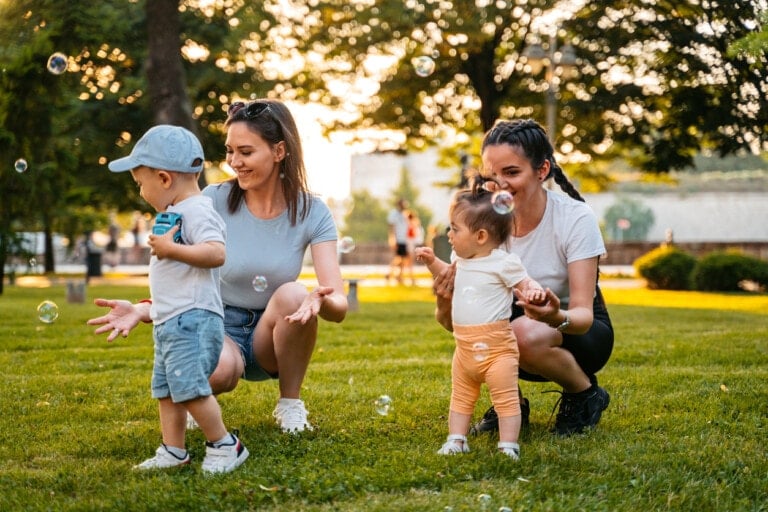My daughter absolutely insists on having important conversations with me while I’m in the bathroom. Whether it be sneaking off for a quick wee, or trying to wash my hair in peace, there she is, telling me about her day or asking me what we are having for dinner. All I ask is for a few moments of privacy; that’s not too much to ask for, right? But it does bring me to an important point. How to teach privacy to kids, when do we need to start teaching it, and why is it important?
Privacy is about boundaries, and more specifically, about respecting someone else’s boundaries or being able to communicate your boundaries. For me, it has been shutting the door and telling my daughter I won’t speak with her or answer questions while I’m in the bathroom and equally respecting her own need for privacy. It’s a sad reality that we also need to consider the safety impacts of teaching our kids about privacy, their body parts, and consent. Research indicates that children who feel comfortable expressing their boundaries, naming their body parts using correct anatomical terms, and understanding consent are protective factors. This means they are much less likely to experience abuse or sexual harm.1,2
How to Teach the Concept of Privacy to Kids
Let’s examine some ways to explain privacy to your child and teach them how to respect other people’s privacy and communicate their boundaries.
Explain What Personal Space Looks Like
Everyone has a circle around them, and each person’s circle is a different size, as is their comfort level or sense of safety around who, if anyone, can come into their circle. You could try a game of “closer or further” and get them to start thinking about how far they want to let you into their space. They could invite you to come closer or step further away. It’s a fun little game, but it also gets them using language and considering their invisible circle. As a rule of thumb, you could teach them about standing with their hands on their hips or arms outstretched to demonstrate a circle or protected space around them. You can also reiterate that it’s up to them to invite or allow specific people into their circle, and they can remove their consent at any time.
Explain How Consent Works
Consent is tricky for little people to understand, but the conversation should start when they are very young. This includes sharing information that their genitals or parts of their body covered by a bathing suit are private and using their correct names (penis, vulva, or vagina). It’s also about modeling how to ask for consent and respect boundaries.3
For example, even when they are babies, you can narrate things like bathing them or changing their nappies. We need to clean and change them (that’s not negotiable) but helping them feel part of the process can increase their sense of comfort. As they age, it will be about seeing their developmental capacity and inviting them to take care of their personal care.
Also, teach them that “one yes doesn’t mean a forever yes” because maybe on one visit, they want to hug a favorite relative goodbye, but on another, they don’t. They need your support to know that this is not just fine but accepted and supported.
Don’t Force Affection
It’s essential that you don’t force your child to hug or kiss anyone goodbye, hello, or express thanks, not even family, and no, not even toward yourself or another parent or primary caregiver. We don’t want to confuse them about boundaries or consent and create rules or circumstances where they feel forced to use their bodies to express gratitude or communicate a sense of welcome.1,2 You can ask if they would like to offer contact with their body with a hug, kiss, or high five, but also provide other options, like saying “goodbye.”
Be Their Role Model for Boundaries
Show them your boundaries and consent so they can see what it looks like and sounds like when someone expresses their need for privacy. Seek their permission before you touch their belongings or ask them if it’s okay if you help them tie their shoes or button their shirt. Respect their answer and equally demand the same in response to your boundaries.4
Teach Them Rules or Social Expectations
This can include house rules or rules in public, things like shutting the door to go to the bathroom, asking for permission to come into a person’s bedroom, and the difference between private and public conversations. You could write this list up and keep it somewhere visible, and as they get older, you can adapt or add to the list.
Teach Them the Difference Between Secrets, Surprises, and Privacy
Explain that secrets aren’t allowed and focus on surprises or privacy instead. Let them know that secrets can feel uncomfortable or that there is no end date and must keep a secret forever. On the other hand, a surprise is something positive, and the time for keeping quiet will end at some point soon. Privacy is also about setting the tone so we can have public or private conversations and differentiate between the two.
For example, I am thrilled for my daughter to ask me many questions about the human body. Still, sometimes the conversation is private, like if she asks about a difference that she has noticed in someone, such as their appearance or behavior. I will tell her I’m happy to answer the question (no questions are off-limits in our house), but I would prefer to have the conversation in private, not public, so the person doesn’t hear us talking about them as we need to be compassionate.
Explain Body Privacy
We need to reduce the concept of shame when we talk about the human body. We should be able to talk about vulvas, nipples, and testicles in the same way we speak about elbows or knees. When we silence our children, get embarrassed, call body parts by cutesy names, or avoid the topic, we accidentally create shame. This shuts down essential conversations, including potential disclosures of abuse or potential harm facing our kids. We need to express that our child’s privates are for them to touch only, or that there might be reasons when a safe adult might need to touch them (wiping, washing, visiting a doctor), but it should never be a secret, and it should always be only when necessary and done quickly.
We must explore our hang-ups or shame associated with our bodies and our sense of comfort around boundaries and consent. This is because we are our kids’ first teachers, and we need to ensure we support them to be body knowledgeable, which will keep them safe. We also need to grow with our children. As they reach different stages of development, their boundaries will evolve, so we need to keep this conversation front and center as their needs evolve. That way, we can support them in cherishing their privacy and respecting the privacy of others.































